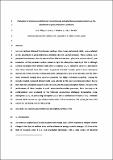Por favor, use este identificador para citar o enlazar a este item:
http://hdl.handle.net/10261/103018COMPARTIR / EXPORTAR:
 SHARE SHARE
 CORE
BASE CORE
BASE
|
|
| Visualizar otros formatos: MARC | Dublin Core | RDF | ORE | MODS | METS | DIDL | DATACITE | |

| Título: | Evaluation of ammonia modified and conventionally activated biomass based carbons as CO2 adsorbents in postcombustion conditions |
Autor: | González Plaza, Marta CSIC ORCID ; García López, Susana CSIC ORCID; Rubiera González, Fernando CSIC ORCID ; Pis Martínez, José Juan CSIC; Pevida García, Covadonga CSIC ORCID | Palabras clave: | CO2 capture Postcombustion Adsorción Biomass |
Fecha de publicación: | jul-2011 | Editor: | Elsevier | Citación: | Separation and Purification Technology 80(1): 96-104 (2011) | Resumen: | Low cost carbons obtained from biomass residues, olive stones and almond shells, were evaluated as CO2 adsorbents in postcombustion conditions (low CO2 partial pressure). These carbons were prepared from biomass chars by means of two different methods: physical activation with CO2 and amination. All the prepared carbons present a high CO2 adsorption capacity at 303 K, although carbons developed from almond shells show a superior CO2/N2 selectivity (lower N2 adsorption) than those obtained from olive stones. In general, activated samples present faster adsorption kinetics due to the presence of transport pores, although they have lower densities. On the other hand, aminated samples have narrower porosities but higher volumetric capacities. Among the samples studied, aminated almond shells were selected as the most promising adsorbent, due to their high CO2 adsorption capacity and selectivity and their good adsorption kinetics. To assess the performance of these samples in cyclic adsorption/desorption processes, basic two-step cycle configurations were evaluated by the following regeneration strategies: temperature swing adsorption (TSA), vacuum swing adsorption (VSA) and a combination of both (VTSA). Aminated almond shells showed no sign of deactivation after 13 h of continuous TSA cycling between 303 and 373 K, nor during VSA or VTSA cycling. | Versión del editor: | http://dx.doi.org/10.1016/j.seppur.2011.04.015 | URI: | http://hdl.handle.net/10261/103018 | DOI: | 10.1016/j.seppur.2011.04.015 | ISSN: | 1383-5866 |
| Aparece en las colecciones: | (INCAR) Artículos |
Ficheros en este ítem:
| Fichero | Descripción | Tamaño | Formato | |
|---|---|---|---|---|
| Evaluation_amonia_Plaza.pdf | 392,68 kB | Adobe PDF |  Visualizar/Abrir |
CORE Recommender
SCOPUSTM
Citations
95
checked on 12-abr-2024
WEB OF SCIENCETM
Citations
84
checked on 26-feb-2024
Page view(s)
302
checked on 19-abr-2024
Download(s)
414
checked on 19-abr-2024
Google ScholarTM
Check
Altmetric
Altmetric
NOTA: Los ítems de Digital.CSIC están protegidos por copyright, con todos los derechos reservados, a menos que se indique lo contrario.
